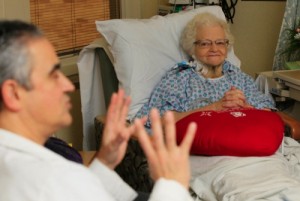Minimally Invasive Options For High Risk Heart Surgery
Traditionally, heart surgery requires cutting into the breast bone, breaking ribs, or performing large incisions and usually it is a high-risk surgery that is not recommended for patients of old age. However, with new advances in heart surgery, Dr. Ciuffo now offers a surgery that can be performed on patients that would normally be too frail for the procedure. This minimally invasive approach to heart surgery is different from traditional high risk heart surgery and offers many benefits, including a short two to three day recovery time!

The Minimally Invasive Option
If you require heart surgery, there are other options besides traditional surgery, that prevent the typical side effects of pain and have long recovery times. Dr. Ciuffo can operate on elderly, high-risk, and even “inoperable” patients who need this surgery. Dr. Ciuffo and his staff are more than willing to answer any questions or address any concerns you may have about this type of procedure, so do not hesitate to ask!
Traditional cardiac surgery requires doctors to cut into the patient’s breast bone, use a heart-lung machine, and requires blood transfusions. Luckily there is a minimally invasive heart surgery opion. Minimally invasive heart surgery does not require the use of any of these steps during surgery and allows for patients who are elderly, frail, or high-risk to have a fast and easy recovery. Dr. Ciuffo is focused on ensuring his patients return to their normal lifestyle as quickly as possible.
Advantages of a Minithoracotomy (Minimally Invasive Heart Surgery)
- The biggest advantage stems from the fact that there is no need to break any bone with a minithoracotomy. The surgical incision is carried out through a thin muscle layer between the ribs. The avoidance of a split in the breast bone and ribs gives less pain, less chances of wound infection, less bleeding and a much more reliable healing of the surgical wound. With these less invasive techniques, high risk patients are more able to undergo surgery.
- It is easier to have an excellent pain control by injecting local anesthetic in the nerves between the ribs (intercostal nerve block).
- It affords a superior cosmetic result by placing the small scar way below the neck and away from the midline towards the side of the chest. In women the scar can often be hidden in the skin fold underneath the breast.
- Even high risk heart surgery patients can resume their normal activities much faster because there are no restrictions in driving a car or carrying weights other than the patient’s own comfort level. These restrictions are routinely imposed on patients with sternotomies or ministernotomies to allow the broken sternum to heal for about six weeks before allowing any mechanical stress. If mechanical stress is applied before that time the breast bone is fully healed, the two halves of this bone might not “stick” well to each other.
- More cannulation options (choices in how to connect the heart lung machine) are available through a minithoracomy.
Disadvantages of a Ministernotomy (Traditional Heart Surgery)
- The breast bone is split lengthwise and across. The wound complication rates, bleeding, pain, chance of infection are pretty much the same as a full sternotomy. As a matter of fact it might actually take a little longer to heal because it has been split in two different directions. High risk patients are unable to undergo this type of surgery.
- Local anesthetic injections do not work as well for local pain control.
- There is definitely very little, if any, cosmetic advantage since the surgical scar is right in the midline in the upper part of the chest. If you wear a shirt or a blouse, it is still the part of the scar you see whether you had a ministernotomy or a full sternotomy.
- You still need downtime to recover and heal the split breast bone. You have to refrain from driving and moderate physical activity for a length of time to allow proper bone healing, same as it happens with a full traditional sternotomy.
Get A Second Opinion For Your High Risk Heart Surgery
If you’ve been diagnosed as inoperable or high risk, please know that this is not final. Dr. Ciuffo has lots of experience with high risk patients, and works every day to create surgical plans to save and extend lives by many years. Some surgeons and doctors simply do not have the knowledge, expertise, or ability to perform minimally invasive surgeries.
Dr. Ciuffo is an expert in high risk heart surgery cases. He can evaluate your case and handle risk factors with our bloodless and minimally invasive techniques with excellent results. Request your second opinion.
Dr. Ciuffo has helped many patients improve and extend their lives. Read their success stories and learn more about why you may have been diagnosed this way.
